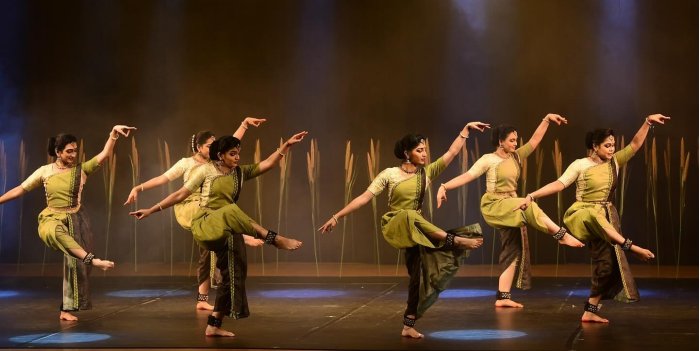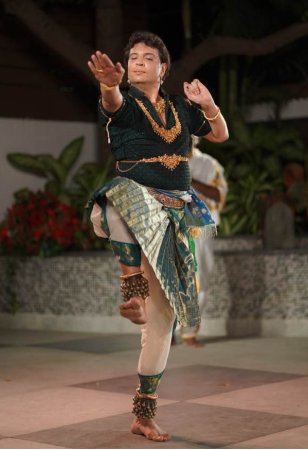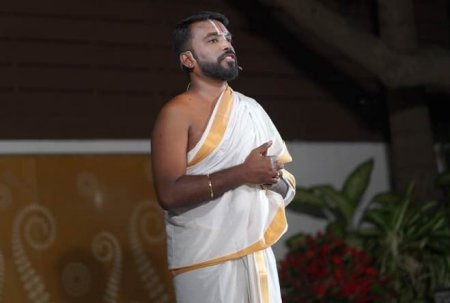
|   |

|   |
 e-mail: leelakaverivenkat@gmail.com Simple tale of 'Arisi: Rice' spins lavish cross cultural entertainment January 28, 2024 The occasion under the aegis of the Music Academy was the Usha Marti Subrahmanyam Endowment Dance Program on Jan 15, 2024, with a packed hall of Chennai's socialites, treated to Singapore-based Apsaras Arts Dance Company's presentation of a lavish multidisciplinary production, innovatively conceived by Artistic Director Aravinth Kumarasamy, designed on what is taken for granted as a mundane everyday part of life - namely ARISI:RICE! Sharing the stage were Bharatanatyam dancers of Apsaras Arts, guest dancers from India, and Balinese dancers from the GEOK Ensemble.  Arisi Photo courtesy: Madras Music Academy Apart from his unique thematic choice, Aravinth's treatment of the subject as a common thread of staple food running across communities in Asia, threw the spotlight on how a human being's life from birth to death with rites and rituals highlighting significant moments, was fashioned round this principal ingredient. (To mention a few examples - Music of the plough, rice planting, annaprashnam of a one year old, Aksharabhyasam marking the start of education, blessing of young married couples, Thai Pongal, Makarashankaranti, etc were all caught in vivid scenes). Contrasting with the choreographed glamour of dance scenes celebrating various events, were film clips catching hard realities of migrant labour hailing from a lineage of rice farming in South India, with personal narrations surrounding lives, where Monsoon vagaries dictate fluctuating fortunes of prosperity and hardships. Music was equally varied with Dr.Rajkumar Bharathi's music compositions keeping company with music by the Chinese orchestra of Singapore - the instruments ranging from the flute (Navin), sarod (Pratik Srivastava), percussions (Ganapathi Venkatasubramaniam), Konnakol (Mahesh Vinayakram), nattuvangam (Sheejith Krishna), Nadaswaram, to music provided by Erhu (Ling Hock Siang), percussions (Benjamin Boo), Dizi (Lee Jun Cheng), Yangpin (Ma Huan) and Guzheng (Xu Hui). The singing included Indian vocalists G Srikanth, Chitra Poornima Sathish, Sathya Prakash, Meenakshi Ilayarajah, Rahul Raveendran and Savithri Sai.  Arisi Photo courtesy: Madras Music Academy Stealing the thunder was Wong Chee Wai's simple and very artistic set design. While the sheer dazzle of colour and movement evoked audience adulation, in aesthetics of tasteful costuming and presentation, it was hard to beat the Balinese dance scenes choreographed by Indonesian Professor I Wayan Dibia. The very lively Bharatanatyam, comprising largely frontal treatment, choreographed by Mohanapriyan Thavarajah of Singapore (with mentorship by India's Priyadarsini Govind) also showed fine group synchronization, apart from being rendered with joyful involvement and technical prowess. One could not help feeling that a few scenes tended to be somewhat over stretched, losing out thereby, on optimum effect. The prime examples were the opening scene on the part played by Rice in Hindu funerals and death rites. So too was the one showing the importance of rice in the initiation ceremony of the young Devadasi. The scene as metaphor showing the beloved longing for uniting with her lover, portrayed through the maturing paddy grains beseeching the sun as lover, to rise and shine and quicken their coming of age through its warmth of love had its share of applause, but for one with sensibilities shaped by age old conventions of classicism, seemed a bit too studied and posey. As pure relaxation and painless entertainment, the evening had staunch support. EXPLORING UNCHARTERED WATERS STATIONED IN HERITAGE ISLAND The Narthaki Studio Series held amidst the very special ambience of Anita Ratnam's home has over the years, offered performance space for off-beat programs not attracting conventional Sabha patronage, during the Chennai Season. For a direct descendent from an exalted hereditary lineage, unfair comparison with family legends can, apart from stifling individual artistic freedom, become like an albatross round the neck.  Aniruddha Knight Hailing from a powerful musical tradition, wherein the reason-to-be for the Dance, is the Music, Aniruddha Knight, as performer, while remaining faithful to the musical heritage, (expressed in movement improvisation in Bharatanatyam through gestures and abhinaya) has shown himself to be a fine teacher. Firmly anchored in tradition, he now takes a careful step as an artist with the right to explore - by interpreting Tevaram poetry. An oral tradition today, comprising late 6th century, 7th and 8th century Shaivite poetry by Appar, Sambandar and Sundarar, it is recited in Shiva temples in the South by Oduvars, this oral tradition having come to us canonized in the 10th century in the era of Rajaraja Chola, who is believed to have recovered these hymns, with the help of a priest Nambiandar Nambi. Revival of Shaivism when Buddhism was at its height, and Agamic form of worship resulted from this Tamil poetry which could reach out to the common man more easily than Vedic Sanskrit. The evening began on a very traditional note with the dancer presenting an edited version of the Usseni Swarajati E mayaladira na sami - with the accompaniment provided by the serene musicality, with all the clarity of enunciation, by his team of musicians honed in the heritage he belongs to. It comprised vocalists Usha Shivakumar and Saraswati Shankaranarayanan, Adyar Gopinath on mridangam, Hariprasad on kanjira and T.V. Sukanya on the violin and the nattuvangam by two of Aniruddha's students Abhinaya Sentil and Maharani. It was thanks to Anita Ratnam that Aniruddha came into contact with Madhusudan Kalaichelvan, an authority on Tevaram hymns, leading to the two working together on this new enterprise. Very much part of the temple tradition, Tevaram is however outside the musical heritage, so central to what Aniruddha was trained in. The choice of Sundarar's poetry was interesting. Pertaining to the end of 7th and first quarter of 8th century (approximate date), Sundarar born to a Brahman family and later adopted by a feudatory family was named Arurar after Shiva. Said to have been bonded to Shiva at Tiruvarur through a palm leaf document, Sundarar's life was spent moving from Tiruvallur to Tiruvottriyur, and back to the temple at Tiruvarur. Going blind, he later regained his sight.  Madhusudan Kalaichelvan As tambiran tozhan, he considered himself as being on equal terms with Shiva, a friend and brother with whom he could take liberties without having to resort to protocol. Addressing Shiva with a familiarity which even smacked of irreverence (pittapiraichoodi - a mad man), in his poetry, he mentions his idiosyncratic accoutrements and unusual family with elephant headed Ganesh as one son and Subrahmanya with two wives on the other, and demands that he come to his rescue and provide the wherewithal to be able to feed the ever growing bhaktas in his temple kitchen. Responding to Kalaichelvan's recitation of Sundarar's poetry by interpreting the same through gestures and expressions, Aniruddha followed it up with a popular much rendered Padam from his heritage, wherein Parvati's mother in the same note of irreverence, in a Ninda Stuti, asks Parvati what she sees in this Shiva (Paitiyakkaran Gangadharan) with his Bohemian traits, to have lost her heart to him. "Ettai kandu icchai kondai magale" in Kalyani, of course, saw the dancer on familiar terrain. Since this program was built round the concept of Hari Hara, after Shiva, the next composition was on Hari, based on 9th century Azhwar poet Nammazhwar, and poetry based on Nalayira Divya Prabandham - the detailed recitation of which, particularly during Margazhi, one is familiar with. Quite opposed to Ninda Stuti, here it is poetry in adoration of the Lord. And following the sringar in the poetry came the well-known Kshetragna padam Kuvalayakshiro in Gaulipantu, built round the swaadheenapatika heroine, full of confidence in the love of her Lord, boasting of how much a part of her he is - not even the odd dalliances with other women can take away from the place she occupies in his heart. Resplendent in his individualistic style of costuming, in a bottle green upper garment, that the dancer was in his element and able to establish a rapport with the audience - who remain out of reach in large performance spaces - this intimate evening with a small audience, had its own charm. WELL DESERVED LIFETIME ACHIEVEMENT AWARD  Bragha Bessell Seldom has a Lifetime Achievement Award evoked such a warm response of total approbation, as when Bragha Bessell received one bestowed on her by Prof. M. Ekambaranathan Educational and Charitable Trust on an evening arranged at Tag Centre. To have happened to arrive at Chennai just a few days before was my good fortune! It was about four decades ago, when I remember to have been treated to a performance by Bragha at one of the many Sabhas and for the first time it was like being hit by a bolt from the blue, after being treated to a real experience of the Dancer becoming the dance! What the Nayika in the varnam had visualized, was the dancing Nataraja. In the total self-effacement, the dancer Bragha did not exist. After this centrepiece, came some Padams - and again I wondered at how totally negating her own persona, in what was being portrayed, was this dancer. The next morning in my daughter's home, I seemed to hear the doorbell hesitantly rung, and opening it, I saw an almost apologetic Bragha standing with a tray of fruit, before the steps, asking if she could come in. That marked my first meeting with Bragha. It did not take me long to find out that what is described as negating the dancer's Self in the dance, in order to evoke rasa, in Bragha's case, is natural, for here is a dancer without a shred of ego or conceit. So there is nothing to wipe out. She represents clean space wherein the dancer's emotions can play to evoke rasa naturally. Throughout the function it was clear, through every speech by artistes that praise will sit lightly on such humility as Bragha's. May she be blessed with many more years of serving students and the Dance!  Writing on the dance scene for the last forty years, Leela Venkataraman's incisive comments on performances of all dance forms, participation in dance discussions both in India and abroad, and as a regular contributor to Hindu Friday Review, journals like Sruti and Nartanam, makes her voice respected for its balanced critiquing. She is the author of several books like Indian Classical dance: Tradition in Transition, Classical Dance in India and Indian Classical dance: The Renaissance and Beyond. Post your comments Pl provide your name and email id along with your comment. All appropriate comments posted with name and email id in the blog will also be featured in the site. |